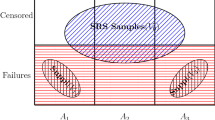Abstract
Case-cohort design has been widely advocated in large cohort studies when the disease rate is low. When the event is not rare, it is desirable to consider a generalized case-cohort design where the covariates are observed only for a subcohort randomly selected from the underlying cohort and a subset of additional failures outside the subcohort. In this article, we propose the smoothed weighted Gehan estimating equation for regression parameters in the accelerated failure time model under generalized case-cohort design. Asymptotic properties of the proposed estimators are developed. To demonstrate the effectiveness of the generalized case-cohort sampling, we compare it with simple random sampling in terms of asymptotic relative efficiency. Furthermore, we derive the optimal allocation of the subsamples for the proposed design. The performance of the finite sample properties are evaluated via simulation studies. A real data set is analyzed to illustrate the estimating procedure.
Similar content being viewed by others
References
Anderson, P. K., & Gill, R. D. (1982). Cox’s regression model for counting processes: a large sample study. Annals of Statistics, 10, 1100–1120.
Brown, B. M., & Wang, Y. G. (2007). Induced smoothing for rank regression with censored survival times. Statistics in Medicine, 26, 828–836.
Cai, J., & Zeng, D. (2007). Power calculation for case-cohort studies with nonrare events. Biometrics, 63, 1288–1295.
Chen, K. (2001). Generalized case-cohort sampling. Journal of the Royal Statistical Society: Series B, 63, 791–809.
Chen, K., & Lo, S. H. (1999). Case–cohort and case–control analysis with Cox’s model. Biometrika, 86, 755–764.
Chiou, S., Kang, S., & Yan, J. (2014). Fast accelerated failure time modeling for case-cohort data. Statistics and Computing, 24, 559–568.
Cox, D. R. (1972). Regression models and life tables (with discussion). Journal of the Royal Statistical Society: Series B, 34, 187–220.
Fygenson, M., & Ritov, Y. (1994). Monotone estimating equations for censored data. Annals of Statistics, 22, 732–746.
Green, D. M., Breslow, N. E., Beckwith, J. B., et al. (1998). Comparison between single-dose and divided-dose administration of dactinomycin and doxorubicin for patients with Wilms tumor: a report from the national Wilms Tumor study. Journal of Clinical Oncology, 16, 237–245.
Horvitz, D., & Thompson, D. (1951). A Generalization of sampling without replacement from a finite universe. Journal of the American Statistical Association, 47, 663–685.
Jin, Z., Lin, D. Y., Wei, L. J., & Ying, Z. (2003). Rank-based inference for the accelerated failure time model. Biometrika, 90, 341–353.
Johnson, L. M., & Strawderman, R. L. (2009). Induced smoothing for the semiparametric accelerated failure time model: asymptotics and extensions to clustered data. Biometrika, 96, 577–590.
Kalbfleisch, J. D., & Lawless, J. F. (1988). Likelihood analysis of multi-state models for disease incidence and mortality. Statistics in Medicine, 7, 147–160.
Kang, S., & Cai, J. (2009). Marginal hazards model for case-cohort studies with multiple disease outcomes. Biometrika, 96, 887–901.
Kong, L., & Cai, J. (2009). Case–cohort analysis with accelerated failure time model. Biometrics, 65, 135–142.
Kong, L., Cai, J., & Sen, P. K. (2004). Weighted estimating equations for semiparametric transformation models with censored data from a case-cohort design. Biometrika, 91, 305–319.
Kulich, M., & Lin, D. Y. (2000). Additive hazards regression with covariate measurement error. Journal of the American Statistical Association, 95, 238–248.
Lai, T. L., & Ying, Z. (1991). Rank regression methods for left truncated and right-censored data. Annals of Statistics, 19, 531–556.
Lin, D. Y., & Ying, Z. (1993). Cox regression with incomplete covariate measurements. Journal of the American Statistical Association, 88, 1341–1349.
Nan, B., Yu, M., & Kalbfleisch, J. D. (2006). Censored linear regression for case-cohort studies. Biometrica, 93, 747–762.
Pollard, D. (1990). Empirical processes: theory and applications. Hayward: Institute of Mathematical Statistics.
Prentice, R. L. (1986). A case-cohort design for epidemiologic cohort studies and disease prevention trials. Biometrika, 73, 1–11.
Self, S. G., & Prentice, R. L. (1988). Asymptotic distribution theory and efficiency results for case-cohort studies. Annals of Statistics, 16, 64–81.
Sun, J., Sun, L., & Flournoy, N. (2004). Additive Hazards model for competing risks analysis of the case-cohort design. Communications in Statistics - Theory and Methods, 33, 351–366.
Tsiatis, A. A. (1990). Estimating regression parameters using linear rank tests for censored data. Annals of Statistics, 18, 354–372.
van der Vaart, A. W., & Wellner, J. A. (1996). Weak convergence and empirical processes. New York: Springer-Verlag.
Wei, L. J., Ying, Z., & Lin, D. Y. (1990). Linear regression analysis of censored survival data based on rank test. Biometrika, 77, 845–851.
Ying, Z. (1993). A large sample study of rank estimation for censored regression data. Annals of Statistics, 21, 76–99.
Yu, J., Liu, Y., Cai, J., Sandler, D. P., & Zhou, H. (2016). Outcome-dependent sampling design and inference for Coxs proportional hazards Model. Journal of Statistical Planning and Inference, 178, 24–36.
Yu, J., Liu, Y., Sandler, D. P., & Zhou, H. (2015). Statistical inference for the additive hazards model under outcome-dependent sampling. The Canadian Journal of Statistics, 43, 436–453.
Yu, J., Shi, Y., Yang, Q., & Liu, Y. (2014). Additive hazards regression under generalized case-cohort sampling. Acta Mathematica Sinica, English Series, 30, 251–260.
Author information
Authors and Affiliations
Corresponding author
Rights and permissions
About this article
Cite this article
Cao, Y., Yang, Q. & Yu, J. Optimal generalized case-cohort analysis with accelerated failure time model. J. Korean Stat. Soc. 46, 298–307 (2017). https://doi.org/10.1016/j.jkss.2016.10.006
Received:
Accepted:
Published:
Issue Date:
DOI: https://doi.org/10.1016/j.jkss.2016.10.006




